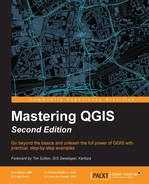 Summary
by GISP Dr. John Van Hoesen, Dr. Luigi Pirelli, GISP Dr. Richard Smith Jr., GISP Ku
Mastering QGIS - Second Edition
Summary
by GISP Dr. John Van Hoesen, Dr. Luigi Pirelli, GISP Dr. Richard Smith Jr., GISP Ku
Mastering QGIS - Second Edition
- Mastering QGIS - Second Edition
- Mastering QGIS - Second Edition
- Credits
- Foreword
- About the Authors
- About the Reviewer
- www.PacktPub.com
- Preface
- 1. A Refreshing Look at QGIS
- 2. Creating Spatial Databases
- 3. Styling Raster and Vector Data
- Choosing and managing colors
- Managing color ramps
- Styling singleband rasters
- Styling multiband rasters
- Creating a raster composite
- Raster color rendering
- Raster resampling
- Styling vectors
- Vector layer rendering
- Using diagrams to display thematic data
- Saving, loading, and setting default styles
- Summary
- 4. Preparing Vector Data for Processing
- Merging shapefiles
- Creating spatial indices
- Checking for geometry errors
- Converting vector geometries
- Creating polygon centroids
- Converting polygons to lines and lines to polygons
- Creating polygons surrounding individual points
- Extracting nodes from lines and polygons
- Simplifying and densifying features
- Converting between multipart and singlepart features
- Adding geometry columns to an attribute table
- Using basic vector geoprocessing tools
- Defining coordinate reference systems
- Viewing a statistical summary of vector layers
- Advanced field calculations
- Conditional formatting for attribute table cells
- Complex spatial and aspatial queries
- Summary
- 5. Preparing Raster Data for Processing
- 6. Advanced Data Creation and Editing
- 7. Advanced Data Visualization
- 8. The Processing Toolbox
- About the Processing Toolbox
- Performing raster analyses with GRASS
- SAGA
- Evaluating a habitat
- Calculating elevation ranges using the SAGA Raster calculator
- Clipping land use to the park boundary using Clip grid with polygon
- Querying land use for only surface water using SAGA Raster calculator
- Finding proximity to surface water using GDAL Proximity
- Querying the proximity for 1,000 meters of water using GDAL Raster calculator
- Reclassifying land use using the Reclassify grid values tool
- Combining raster layers using SAGA Raster calculator
- Evaluating a habitat
- Exploring hydrologic analyses with TauDEM
- R
- LAStools and Fusion
- Summary
- 9. Automating Workflows with the Graphical Modeler
- An introduction to the graphical modeler
- Opening the graphical modeler
- Configuring the modeler and naming a model
- Adding data inputs to your model
- Adding algorithms to your model
- Running a model
- Editing a model
- Documenting a model
- Saving, loading, and exporting models
- Executing model algorithms iteratively
- Nesting models
- Using batch processing with models
- Converting a model into a Python script
- Summary
- 10. Creating QGIS Plugins with PyQGIS and Problem Solving
- Webography – where to get API information and PyQGIS help
- The Python Console
- My second PyQGIS code snippet – looping the layer features
- Exploring iface and QGis
- Exploring a QGIS API in the Python Console
- Creating a plugin structure with Plugin Builder
- A simple plugin example
- Setting up a debugging environment
- Debugging session example
- Summary
- 11. PyQGIS Scripting
- Where to learn Python basics
- How to load layers
- Vector structure
- Iterating over features
- Editing features
- Running Processing Toolbox algorithms
- Running an external algorithm or command
- Interacting with the map canvas
- Summary
In this chapter, we covered automating workflows with the QGIS graphical modeler. We showed you how to set up, edit, document, and run a model. You learned how to add inputs and algorithms to models. We also covered how to execute models iteratively, nest models within models, and run them in batch mode. With what has been covered up to this point, you should understand how to work with a variety of vector, raster, and tabular data. You should also be well versed in the geoprocessing and analytic capabilities of QGIS.
In the next chapter, we will switch from conducting analyses with the graphical modeler and the Processing Toolbox to expanding the functionality of QGIS with Python. In Chapter 10, Creating QGIS Plugins with PyQGIS and Problem Solving, you will learn how to create a QGIS plugin from scratch. The chapter will begin with a primer on PyQGIS. You'll learn where you can get API information and other PyQGIS help. We will then explore the plugin file structure and the available functions. The chapter will conclude with a simple step-by-step example of writing a QGIS plugin. This will also include information on debugging your code.
-
No Comment